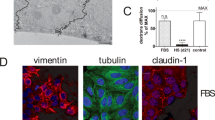Summary
Recent work from our laboratory (Kim and Wolf, J Biol Chem 262: 365–371, 1987) has shown increased uptake of labeled amino acids into fibronectin (FN), increased net synthesis of FN and increased levels of FN-mRNA in primary cultures of hepatocytes from vitamin A-deficient rats compared to controls. We now find, surprisingly, decreased uptake of labeled sugars into the oligosaccharide chains of FN from vitamin A-deficient hepatocytes. This decrease could be reversed by added retinoic acid at physiological concentration. At the same time, FN from deficient hepatocytes (−A.FN) was more susceptible to proteolytic degradation. Decreased uptake of the core sugar mannose into −A.FN was similar to that of glucosamine, yet the percent of label in sialic acid was the same as in +A.FN, suggesting a smaller number of oligosaccharide chains per molecule of −A.FN. Upon enzymatic removal of oligosaccharide and labeling with sodium borotritide, it was found that both −A.FN and +A.FN had biantennary oligosaccharide structures. Selective enzymatic removal of sialic acid showed that +A.FN had both sialic acids in an α2→3 linkage, whereas −A.FN apparently had one α2→3 and one α2→6-linked sialic acid. The borotritide experiments allowed us to calculate that +A.FN appeared to have 5 oligosaccharide chains per FN monomer, whereas the −A. FN showed only 4 chains. These results would account for the decreased glycosylation and increased susceptibility to proteolysis of the −A. FN. We conclude that vitamin A controls both the rate of synthesis of the polypeptide chain of FN via its mRNA, as well as the rate of its glycosylation.
Similar content being viewed by others
Abbreviations
- FN:
-
Fibronectin
- ELISA:
-
Enzyme-linked Immunosorbent Assay
- DOC:
-
Deoxycholate
- TCA:
-
Trichloroacetic Acid
- PMSF:
-
Phenylmethylsulfonyl Fluoride
- PBS:
-
Phosphate-buffered Saline
- BSA:
-
Bovine Serum Albumin
- AGP:
-
Alpha-1 acid Glycoprotein
- SDS-PAGE:
-
Sodium Dodecylsulfate-Polyacrylamide Gel Electrophoresis
References
Zerlauth G, Kim SY, Winner JB, Kim H-Y, Bolmer SD, Wolf G: Vitamin A deficiency and serum or plasma fibronectin in the rat and human subjects. J Nutr 114: 1169–1172, 1984
Kim H-Y, Wolf G: Vitamin A deficiency alters genomic expression for fibronectin in liver and hepatocytes. J Biol Chem 262: 365–371, 1987
Olsen DR, Hickok NJ, Uitto J: Retinoid modulation of ornithine decarboxylase and fibronectin gene expression in human keratinocyte cultures. J Cell Biol 107: 641a, 1989
Wolf G, Kiorpes TC, Masushige S, Schreiber JB, Smith MJ, Anderson RS: Recent evidence of the participation of vitamin A in glycoprotein synthesis. Fed Proc 38: 2540–2543, 1979
De Luca LM: The direct involvement of vitamin A in glycosyl transfer reactions of mammalian membranes. Vitam Horm 35: 1–57, 1977
Chan V, Wolf G: The role of vitamin A in the glycosylation reactions of glycoprotein synthesis in an in vitro system. Bioch J 247: 53–62, 1987
Bernard BA, De Luca LM, Hassel JR, Yamada KM, Olden K: Retinoic acid alters the proportion of high mannose to complex type oligosaccharides on fibronectin secreted by chondrocytes. J Biol Chem 259: 5310–5315, 1984
Bieri J, Tolliver T, Catignani G: Simultaneous determination of α-tocopherol and retinol in plasma or red cells by HPLC. Amer J Clin Nutr 32: 2143–2149, 1979
Seglen PO: Preparation of isolated rat liver cells. Methods of Cell Biol 13: 29–83, 1976
Ruoslahti E, Hayman E, Pierschbacher H, Engvall E: Fibronectin purification, immunochemical properties and biological activity. Methods of Enzymology 82: 803–831, 1982
Hellerstein MK, Sasak V, Ordivas J, Munro HN: Isolation of alpha 1-acid glycoprotein from human plasma using HPLC. Anal Biochem 146: 366–371, 1985
Laemmli UK: Cleavage of structural proteins during assembly of bacteriophage T4. Nature 227: 680–685, 1970
Green ED, Baenziger JU: Oligosaccharide specificities of phaseolus vulgaris leukoagglutinating and erythroagglutinating phytohemagglutinins. J Biol Chem 262: 12018–12029, 1987
Plummer TH, Elder JH, Alexander S, Phelan AW, Tarentino AC: Demonstration of peptide: N-glycosidase F activity in endo-β-N-acetylglucosaminidase F preparations. J Biol Chem 259: 10700–10704, 1984
Takasaki S, Yamashita K, Suzuki K, Iwanaga S, Kobata A: The sugar chains of cold-insoluble globulin. J Biol Chem 254: 8548–8553, 1979
Green ED, Baenziger JU: Separation of anionic oligosaccharides by HPLC. Anal Bioch 158: 42–49, 1986
Amrandi DL, Mauzy-Melitz D, Mosesson MW: Effect of hepatocyte-stimulating factor and glucocorticoids on plasma fibronectin levels. Biochem J 238: 365–371, 1986
Hutton CW, Corfiel AW, Clamp JR, Deppe PA: The gut in the acute phase response: changes in colonic and hepatic enzyme activity in response to dermal inflammation in the rat. Clin Sci 73: 165–169, 1987
Bernard BA, Yamada K, Olden K: Carbohydrates selectively protect a specific domain of fibronectin against protease. J Biol Chem 257: 8549–8554, 1982
Fukuda M, Hakomori S: Carbohydrate structure of galatoprotein α, a major transformation-sensitive glycoprotein released from hamster embryo fibroblasts. J Biol Chem 254: 5451–5457, 1979
Yamaguchi Y, Isemura M, Yosizawa Z, Kan M, Sato A: A weaker gelatin-binding affinity and increased glycosylation of amniotic fluid fibronectin than plasma fibronectin. Int J Biochem 18: 437–444, 1986
Merkle RK, Cummings RD: Relationship of the terminal sequence to the length of poly-N-acetyllactosamine chains in asparagine-linked oligosaccharides from mouse lymphoma cell line BW147. J Biol Chem 262: 8179–8189, 1987
Kasbaoui L, Harb J, Bernard S, Meflah K: Differences in glycosylation rate of fibronectin from two rat colon carcinoma cell lines in relation to tumoral progressiveness. Cancer Res 49: 5317–5322, 1989
Petkovich M, Brand NJ, Krust A, Chambon P: A human retinoic acid receptor which belongs to the family of nuclear receptors. Nature 330: 444–450, 1987
Shankar S, Creek KE, DeLuca LM: The effect of the progression of vitamin A — deficiency on glucose, galactose and mannose incorporation into sugar phosphates and sugar nucleotides in hamster liver. J Nutr 120: 361–374, 1990
Author information
Authors and Affiliations
Rights and permissions
About this article
Cite this article
Kirven, M.J., Wolf, G. Synthesis and glycosylation of fibronectin in hepatocytes from vitamin A-deficient rats. Mol Cell Biochem 101, 101–114 (1991). https://doi.org/10.1007/BF00229528
Received:
Accepted:
Issue Date:
DOI: https://doi.org/10.1007/BF00229528




